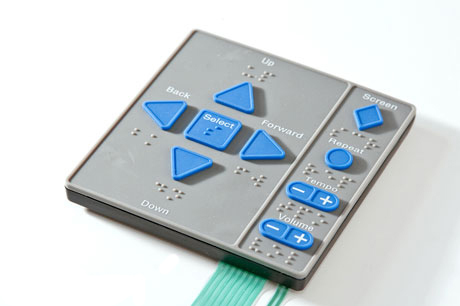Comprehending Membrane Layer Switches: The Trick to Resilient and Trusted Controls

What Are Membrane Layer Switches?
Membrane layer buttons are an advanced remedy in the world of user interface technology, integrating functionality and style perfectly. These gadgets work as a user interface between users and electronic systems, integrating several components into a small style. Normally created from adaptable, slim layers of products, membrane layer buttons are made to react to touch, making it possible for customers to connect with equipment and digital gadgets successfully.
The main components of a membrane layer button include a printed circuit layer, visuals overlay, and a spacer layer that protects against unplanned activation. The visuals overlay can be personalized to show brand name identity or user preferences, boosting aesthetic appeals while making sure usability. Membrane buttons are frequently used in various applications, including medical devices, customer electronic devices, and industrial equipment, owing to their resilience and resistance to ecological factors such as moisture and dirt.
One of the key benefits of membrane buttons is their ability to hold up against deterioration, making them optimal for high-traffic environments. In addition, they are lightweight and require marginal area, permitting cutting-edge styles in product development. Overall, membrane layer switches stand for a effective and useful selection for contemporary electronic interfaces, weding innovation with user-centric design principles.
How Membrane Layer Switches Work
The operation of membrane changes joints on an easy yet reliable mechanism that translates individual input right into digital signals. When an individual presses the button, the leading layer deforms, allowing a conductive aspect in the circuit layer to make call with an equivalent conductive pad on the underside of the graphic overlay.
The style of membrane layer buttons can differ, but they typically include domes or responsive elements to provide comments to the individual, improving the overall experience - membrane switch. The materials utilized in membrane switches, such as polyester or polycarbonate, contribute to their longevity and resistance to environmental elements, including wetness and dirt. The printed circuits are usually enveloped, which protects them from wear and tear over time.
Benefits of Membrane Switches

In addition, membrane layer switches are recognized for their durability. Constructed from robust materials, they are resistant to dust, wetness, and physical wear, which significantly extends their lifespan compared to conventional mechanical switches. This sturdiness makes them especially ideal for high-traffic settings and applications calling for long life.
An additional substantial advantage is the convenience of cleansing and upkeep. The smooth surface area of membrane switches reduces dust accumulation and is often unsusceptible spills, making them optimal for settings that require frequent sanitization.
Moreover, membrane layer buttons supply a structured profile, resulting in a thinner design that can be incorporated right into different devices without adding bulk. This attribute not just improves the aesthetic allure however likewise contributes to a more ergonomic item style.
Applications of Membrane Buttons
Flexible and user-friendly, membrane layer switches locate applications throughout a wide variety of sectors, consisting of medical tools, consumer electronic devices, and commercial equipment. In the clinical field, these switches are indispensable to gadgets such as analysis devices, patient surveillance systems, and mixture pumps, where dependability and ease of cleansing are crucial. Their capacity to stand up to harsh settings and preserve functionality makes them suitable for such applications.

In customer electronics, membrane layer buttons are used in items like microwaves, cleaning machines, and remotes right here - membrane switch. his response Their sleek style enables intuitive individual interfaces, boosting the overall individual experience while giving toughness and resistance to wear and tear
Industrial tools additionally gains from membrane buttons, particularly in control panels for machinery and automation systems. These switches use defense versus dust and moisture, making certain regular performance in challenging atmospheres. Their personalized attributes permit manufacturers to customize them to details functional demands, enhancing efficiency and functionality.
Choosing the Right Membrane Layer Switch
When selecting a membrane switch, it is important to think about numerous aspects that influence performance and suitability for particular applications. The key factors to consider consist of ecological problems, responsive comments, toughness, and style specs.
First, evaluate the operating environment; buttons revealed to wetness, chemicals, or extreme temperatures call for certain materials to guarantee longevity and functionality. Next off, examine the need for responsive comments. Depending upon individual interaction, some applications may profit from a tactile response to validate activation, while others may prefer a non-tactile design for visual factors.
Sturdiness is another essential aspect; membrane switches should be made to stand up to frequent usage, impacts, and abrasion. Make certain the chosen switch can sustain the expected lifecycle, particularly in high-usage situations.

Final Thought
In conclusion, membrane switches over serve as crucial components in the style of reliable and resilient control systems throughout different sectors. my company The versatility of membrane changes permits for customized solutions that meet details operational requirements, strengthening their value in modern technology.
Membrane changes represent an essential aspect of contemporary interface style, blending functionality with durability in different applications.Membrane switches are an advanced option in the world of user interface technology, integrating performance and style seamlessly. Usually built from versatile, thin layers of materials, membrane switches are designed to respond to touch, enabling individuals to communicate with machinery and digital tools properly.
The layout of membrane layer switches can differ, yet they usually include domes or responsive aspects to offer feedback to the user, boosting the total experience.In verdict, membrane layer changes serve as important components in the layout of sturdy and trustworthy control systems throughout various industries.